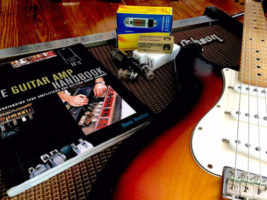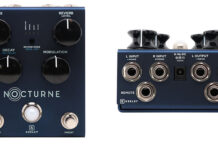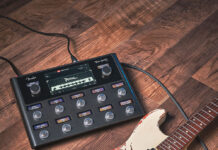
A Guide to Basic Tube Amp Maintenance
Written by Don Stick on behalf of Bands for Hire.
Most guitarists are fairly fanatical about the tube amp. There is something about the glow of hot glass and the imposing sight of weighty iron through the grille that seems to sum up so much of what’s cool about the electric guitar.
Some of the tube amp designs of the last 60 to 70 years have oozed so much aural and visual mojo that it’s difficult to imagine the course of electric guitar playing’s evolution without them. Many of these designs have been refined and re-packaged by now in a bewildering number of (often complex) formats; but the heart of a tube amp and the circuits on which it is based have actually changed very little.
Now, I’m not suggesting that the untrained electrician or the DIY hero should consider going elbows-deep in circuits that can contain upwards of 500 volts.
An open tube amp may have the potential to kill you even when switched off; and even if you have the knowledge, the best tube amps are far too exquisitely engineered under the hood to be messed about with by just anybody.
As with most things though, there is a lot that can be achieved with just a basic level of knowledge—and if nothing else you might save yourself a trip to the amp tech!
Preamp Tubes
These are the smaller tubes that you can see on your amp’s chassis. They are often—but not always—hidden behind metal sheaths that are there primarily to reduce microphonics. Most modern amps are designed around 12AX7 preamp tubes, which have a very high gain factor, and generally the brands that tend to be fitted at the factory (common ones include JJ, Ruby, Sovtek and Shuguang) are robust and will perform well.
Preamp tubes—in terms of reliability—can be thought of a bit like lightbulbs. Most will work well for several years, but occasionally one will fail prematurely for no apparent reason. Tubes can be very consistent but arguably are not made as well as they were in their heyday around 50 years ago—and even with the best production techniques in the world, they are simply being asked to do a lot of work. A 12AX7, which sits in one of the early stages of a high gain circuit, will tend to fail quicker. The more gain you supply it (from higher-output pickups or an aggressive attack) or ask of it (by turning up the gain control), the quicker it will generally wear out. As always, though, there are no hard and fast rules. I’ve owned 15-year-old Peavey 5150 amps that were still running the original tubes; I changed the entire tube complement out of habit, and it yielded no improvement in sound.
Having said all of this, if your amp does start having problems with background noise, microphonics; lower-than-usual gain; poor tone or no sound on one or more channels, the preamp tubes are a great place to start. The first step is to unplug effects from the front end and check your instrument cable against one that is known to be good. A systematic check of all your peripheral components—even your guitar—can pinpoint many problems immediately. Hum issues can be caused by pedal power supplies, a bad supply in the venue, or even running signal cables too close to power cables.
Next, disconnect any effects that are in your loop one-by-one, remove any loop cables and/or disable the effects loop itself. Again, once you have systematically tested each component and each cable you can rule those out. If you’re down to one known-good cable and you find the effects loop itself is at fault, you can try replacing the tube that drives it. Most tube-driven loops are driven and recovered by two halves of the same 12AX7 and the manual or tube chart should make it fairly easy to identify.
At this point you should have tested and verified each and every component in your chain and you are plugged in with a working guitar, via a working cable, with nothing in your effects loop. If you still have noise, poor tone, or one or more channels out you need to start checking the preamp tubes. If all channels are down or the problem is global (amp is extremely quiet, muddy or is making spectacularly unusual noises, emitting smoke and/or the tubes are glowing a funny color), switch it off immediately and either call a trusted amp tech or refer to the next section of this story.
Your amp may have a tube chart affixed to the inside of the headshell in an easily visible location. Most amp manufacturers will make a similar chart available online, so if you have internet available, now is a great time to use it! It’s handy simply to know which preamp tube is V1, V2, V3. etc.—they will generally progress in a reasonably logical order from one side of the chassis to the other, and you can normally suspect the earlier tubes first for tone or background noise issues. If you can’t get your hands on a tube chart, simply turn your amp off, unplug it for safety, remove the appropriate grille from the front or rear of your amp and “roll” a known-good spare tube through each position in turn until the problem goes away. Simple trial and error may get you up and running in a pinch—just bin the faulty tube and carry on!
If you have a channel-switching amp and the problem exists on—for the sake of argument—only two of three channels, your route to a solution may be even simpler. If you have a tube chart telling you that your two affected channels share V1 and V3 for example, you can immediately suspect those tubes. Some amps have a dedicated 12AX7 for the clean channel alone, for example, which can make diagnosing problems with that channel simpler still. Most modern channel switching amps like the Marshall JCM2000, JVM, EVH 5150III and Mesa/Boogie offerings will share tubes between channels in order to improve internal layout, so a logical approach (similar to that used diagnosing a blown fuse in a car) can go a long way. Other amps like the Marshall 6100 Anniversary actually have a discrete set of preamp tubes for each channel, which can make them internally complex but simplifies your job even further when diagnosing preamp tube problems.
Power Tubes
This is the larger set of tubes visible on your chassis. They are generally of either EL34 type (taller, “British” style tubes), 6L6 type (fatter, “American” style tubes) or occasionally manufacturers like Soldano will use 5881 (a robust military-grade 6L6 equivalent). Smaller amps like the Vox AC30, Peavey Classic 30 or a Soldano Astroverb may use EL84 tubes, which are barely any bigger than the 12AX7s in their preamp! Smaller Fender types often use 6V6 tubes, which are also smaller. The first step is to simply identify which tubes your amp relies upon for its power stage, and carry a quality matched pair or quad of the appropriate type. At this stage it’s best not to assume types are interchangeable, although amps like the Carvin Legacy, Cornford MK 50H II, and most modern Mesa/Boogies will accept 6L6 or EL34 via a rear panel switch. The Simul-Class Boogie Mark IV and a handful of others will actually accept two of each type. If in any doubt whatsoever, do not substitute one tube type for another!
Generally, when power amp tubes fail they do so either quickly (amp lights up but produces no sound), or spectacularly (generally by glowing an unusual colour or making loud pops or bangs, followed by complete failure). They can also deteriorate more slowly over time, resulting in a loss of top end detail or low end power. If everything else in your chain is good but your amp just seems to lack sparkle or authority, it’s a great idea to try a new set of power tubes—you may find the old set were still performing well enough to be kept as an emergency “spare spare” set! It’s worth mentioning again at this point that if your amp starts smoking or producing a burning smell, it’s likely that the damage is more extensive. Failed power tubes can sometimes take out their protection circuit, occasionally overheat part of the board, or in extreme cases even blow an output transformer. Switch the amp off immediately, grab a backup (you packed one, right?) and call a tech!
Unlike the preamp tubes, which can replaced on a “plug and play” basis, the power tubes in most amps need to be biased for optimum performance. The phrase “fixed-bias” does not mean the bias is not adjustable, more that it is adjustable but to a fixed ideal point. Power tube bias can be thought of a little like the pressure in a car tyre; too much or too little can result in poor performance characteristics and/or reduced lifespan of the part.
Power tubes are generally biased as a matched set of four (like in most 100W amps), or as a matched pair (like in a 50W amp). Some class AB amps like the Marshall DSL are biased separately on each of their two distinct push and pull “sides,” allowing for two matched pairs to be fitted in place of a matched quad—or in a 50W amp, two unmatched tubes to be fitted in place of a matched pair. This, however, is probably your amp tech’s territory, so if in doubt you should just carry a matched set of whatever tube complement your amp carries.
An unmatched set, or individual replacement of one or two failed tubes will likely get you through a gig, maybe even the remainder of a short tour in a pinch, but the power tubes should always be appropriately matched and correctly biased for optimum long-term performance.
If your amp belongs to the “non-adjustable or preset bias” category (this includes early fixed-bias tweed Fenders and some Mesa/Boogies, among others) this may lead you to believe that any power tubes can be fitted without a compromise in performance, and some marketing tends to further mislead on the subject! What it actually means, in short, is that the amp itself does not feature adjustable bias, and instead the tubes must fall within a safe range for the amp.
Again, like a car tyre, the safe range is fairly broad—a somewhat colder tube set will usually feel slightly less responsive but will last significantly longer, and a hotter set will feel more lively but will wear out quite fast. It’s fairly standard practice for production amps to be biased a little cold from the factory; meaning that even a hotter set of tubes won’t pull them out of the safe range. This is essentially the principle behind a non-adjustable bias amp; it will have a colder bias set at the factory in order to safely accept a wide range of tubes, negating the need for adjustment while maintaining good overall performance. If you have a non-adjustable bias amp, you can either replace your tubes like-for-like (relatively easily done if the existing set have a rating label attached to them), or talk to a reputable tube retailer who will be able to sell you a set that fall within the ideal range.
An interesting case in point: Mesa/Boogie set themselves up many years ago to supply both amps and replacement tube sets matched to those amps. If you are a Mesa/Boogie owner, you can simply replace your factory tubes with an identically rated set, or even change to a different rating for earlier or later breakup and a different playing feel. You pay more for the additional steps involved in testing the tubes (Mesa/Boogie’s testing regimen is among the strictest in the business) but you may save the money back later in increased reliability or by negating the need to have your amp biased regularly. It’s a slightly different way of doing things that may work for youand since Mesa/Boogie are really just testing, re-branding and labelling tubes from other reputable manufacturers such as Ruby and Shuguang, there is no tonal compromise. Equally, if you wish to change brand, you can simply talk to a reputable aftermarket supplier who will specify a set of tubes that match your amp’s requirements.
One final type of amp worth knowing about is the cathode-biased type. These tend to be lower in wattage and are sometimes operating in Class A—another kettle of fish entirely! Cathode biased amps include the Vox AC30, Bad Cat Black Cat 30, Cornford Roadhouse 30 (but not 50), Matchless DC-30, and many more. These can truly be described as self-biasing; they will accept any matched set of appropriate power tubes and—in a nutshell— bias themselves accordingly by design.
It’s also worth being aware at this point that the last 12AX7 tube, the phase splitter or phase inverter (PI), actually belongs to the power amp. Generally, this one will either do its job or won’t, and it will be labelled in the amp’s manual or on its tube chart. I’ve personally never had one fail in twenty years of playing tube amps, but if your PI does fail, it’s a plug-and-play affair. It is also tonally non-critical—so any robust, functioning 12AX7 will do nicely.
Modifications
With a little research, there are many simple preamp modifications that can be performed by the enthusiastic DIY electrician or (perhaps more advisably) by your tech. However, you can tweak your amp’s performance a little without even opening her up. As discussed above, varying your amp’s bias (some amps offer the adjustment via the rear panel) within a safe range can fine-tune its handling characteristics. Changing to a different brand of power tubes altogether offers another way to tune your sound; some brands will be brighter, warmer, fuller, more aggressive or more dynamic and enough alternatives exist to taste-test several over the years, even keeping a couple of sets in rotation. A little time spent researching the varying flavours can point you in the tonal direction you crave – the differences are not vast but they can be surprising, and a set of new tubes is cheaper than a new amp!
Preamp tubes, too, offer an opportunity for user customisation. Even modern, relatively high gain 12AX7s come in various subtly different tonal flavours, and you can change to a lower gain 12AX7 in one or more positions to alter the response of your circuit. Alternatively, swapping one 12AX7 for a 12AU7 or 12AT7 will dramatically lower the gain.
I like to keep a 12AT7 handy—if I find a channel too gainy or sizzly I can substitute it in one position, shaving off 30 to 40 percent of apparent gain without drastically altering the feel or EQ. If you are not a high gain player and find the last channel on your amp unusable, this is a handy trick to know! Similarly, swapping your stock tubes for high gain/low noise Chinese types can have the opposite effect if your amp is a little gain-starved or unresponsive. NOS (new old stock) tubes are often higher in gain and tonally richer than modern alternatives too, but they do command a hefty price tag.
Tube amps are a huge subject; for many guitarists they are a rabbit hole as deep and as fascinating as the playing itself. Most of the world’s great designers and modders were players first (Leo Fender and Jim Marshall were two major exceptions!) and often the playing feel, even more than the sound, is what makes a good circuit great. Most of the great original guitar circuits were derived from nearly 100-year-old radio manuals, and many of the best modders (including the famous Mike Soldano) were self-taught. If you want to learn more along these lines, I recommend Dave Hunter’s The Guitar Amp Handbook, which digs a lot deeper.
Written by Don Stick on behalf of Bands for Hire.
Source: www.guitarworld.com











